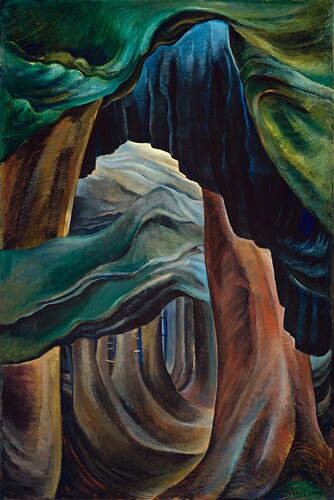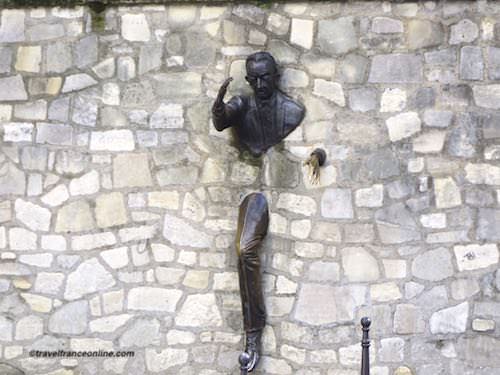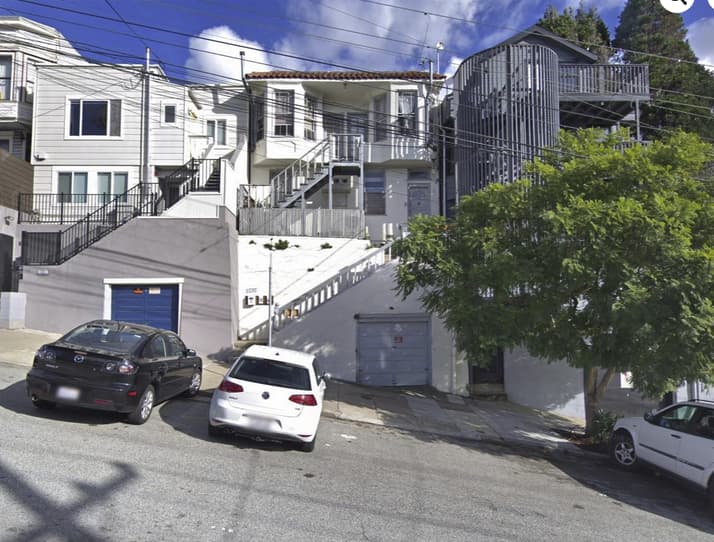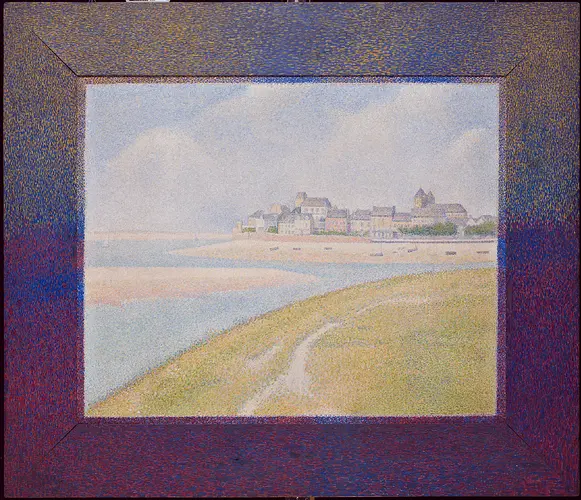If you still have the chat open, tell it it was wrong. It needs to learn from its mistakes and does.
- I did, and the last attribution was the one that it sent me: “Thank you for catching that — let’s reassess carefully.”
The enveloping forest, with its towering spires majestic over the church.
Of course, this is completely my own particular subjective response. Carr appreciated native spirituality concerning nature, but I’ve no idea what she intended.
@rsewell has good taste ;-). Having grown up in the forests of the pacific northwest myself, Emily Carr also ranks among my favourite visual artists. I particularly enjoy the towering moodiness of the forest conveyed in this one: (Emily Carr, “Forest”, 1932).
I think the image supports your response, too.
John Denver sang: “In rocky cathederals that reach to the sky.”
Absolutely.
“Le Bon Samaritain / The Good Samaritan” by Aimé Nicolas Morot (1880)
This copy is from wikimedia. But I have two shots of it taken in the (Musée des Beaux-Arts de la ville de Paris).
Some day I hope to see (any of) Fujimura’s work in person.
This is “Walking on Water - Glaciers” by Makoto Fujimura:

Fujimura writes extensively on art, faith and resisting “culture war” by practicing “culture care,” his name for the gentle form of Christian activism which includes real work promoting justice.
I have tried to be involved in a discussion elsewhere about the problem of Christian nationalism. It’s focus on reliance on power and coersion strike me as contrary to the Gospel. Fujimura promotes a better alternative by living one’s faith in a way that seeks to serve and to demonstrate the beauty and love of Jesus Christ, rather than to impose and rely on force - the abuse of power.
This is a magnificent piece, Terry.
Love his work. He was at a Biologos conference a few years back, and I have been following him since then.
- I can’t find my copy, but fortunately there others on the Internet:
- Le Passe-Muraille, or “The Man Who Walks Through Walls,” stands as a large bronze sculpture, capturing the essence of a man seemingly ensnared halfway within a stone barrier. Nestled within a secluded car park on rue Norvins in Montmartre, this remarkable artwork was brought to life by the talented French actor and sculptor Jean Marais in 1989.
- https://www.travelfranceonline.com/le-passe-muraille-montmartre-paris/
Le Passe-Muraille – Montmartre Paris
- Not because of the subject, but because of the Pointillist mode of painting:
To get the best view of the mode, find a copy of this or a painting by Georges Seurat (the more pixels the better) like the copy available as a download at https://artvee.com/dl/women-at-the-well-2/ and examine it up close, really up close.
Marvelous! Must’ve taken a lot work. I’ve set it up as my wallpaper ![]()
I also got interested in Pointillism by way of my wife who is a weaver. When we met in 1982 she had just completed two pieces which were woven and then painted with dyes in that style. They were the only two weavings she made over the course of a year because of the time they took and she has never done another since. I took the first image as a screenshot from her website. I took the photo of that piece from an angle at an exhibition in 2017. I included the card about it which I shot at that show.
The thing about art appreciation is that it is definately in the eyes of the beholder. I don’t know if anyone here watches Portrait Artist of the year (or its sister program, Landscape Artist of the year) Very rarely do I align myself with the judges.
On the other hand you can’t hep but admire the skill and patience of the weaving displayed by @MarkD .
Richard
I have to start looking for Lia’s work to see in person. Your photos are beautiful, but I can tell they only convey a small part of the work, particularly but not exclusively the texture.
It must be daunting to face the same project each day for so long as well. Particularly as one gets closer to finishing. The stakes are higher with each new, successful daub.
Thanks so much for sharing this piece, Mark.
Aye, when we lived in San Francisco, Esther enrolled in a short beginner’s weaving class. I think I may have been more excited about it than she was. There was a great store in north Berkeley, I think it was, that sold anything and everything needed or useful in weaving, from yarns to beautiful, multi-thousand dollar looms. We were poorer then, but I was sure we’d eventually have enough to get one. Sadly, it was a craft that Esther decided not to pursue. Probably, just as well. We lived in a small one-bedroom apartment three floors up from the street and the thought of trying find space for loom almost as big as our bed was challenging.
1035 De Haro Street, San Francisco, California. Esther’s and my first domicile when we married in August 1980. The apartment on the third floor left in the bright white building in the middle. Walk in the front door, through the living room, bedroom, kitchen and out the back door . . . into the backyard.
That sounds like Straw Into Gold. No longer exists of course. But Lia says they had nearly everything. I looked in vain on her website for the other Pointillist inspired piece but it wasn’t there. When I told her she brought up a thumbnail from her dropbox account. Nice but I still prefer 2.4.
Speaking of Pointillism and Seurat, I grew up with this gem at the DIA. I remember on a field trip in 3rd or 4th grade puzzling over the frame which Seurat painted as well and discussing it with our art teacher. Now I think about the choice of frame for paintings nearly as much as the paintings themselves. How do they succed or fail to work together? How does this frame, or how would a different frame or mode of presentation affect viewer’s experience, etc.
Beautiful,love the way it pulls you in.








